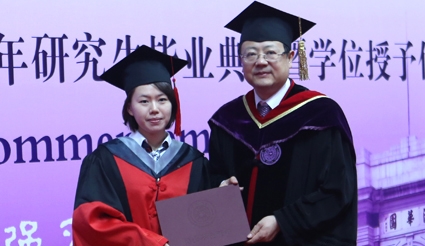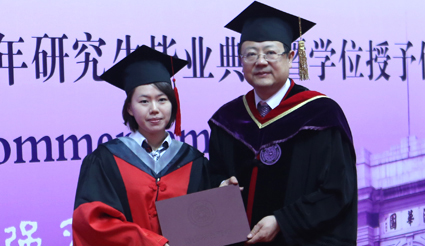
当前课程知识点:学术英语 > Welcome to EAP course 欢迎学习“学术英语课程” > Extended reading Unit 1 > html
Reading 2
Not All Processed Foods Are Bad for You
Cara Rosenbloom
1 Ah, processed foods. The term has become a sweeping generalization for anything that comes in a bag or a box. Even my nutrition advice usually includes the general statement “eat less processed food and choose fresh food instead.” But that sentence really simplifies a more complex story.
2 Of course, how we process the food matters. Some ingredients can undergo changes — like being frozen, fermented or sprouted — that makes them equally or more nutritious than they once were. Not all processes are detrimental. Here’s how to tell the difference.
3 An apple is more nutritious than applesauce, and both are better choices than apple pie. The more processed a food is from its original state, the less healthy it becomes. To make it easier to discern just how processed a food is, researchers have developed categories for four distinct groups of foods. Take note of what goes in your grocery cart — and your body — based on these categories:
4 Group 1 — Unprocessed and minimally processed foods: This group includes basic whole foods such as vegetables, fruits, nuts, eggs, meat and milk. If processing is used, it’s to preserve shelf life, such as freezing vegetables and vacuum-sealing meat. This group makes up about 30 percent of the calories we eat — but the number should be higher for these nutritious options.
5 Group 2 — Processed cooking ingredients: These foods enhance the flavor of meals and include olive oil, salt, honey and dried herbs. Some like olive oil are more nutritious than others like sugar, but they only account for 3 percent of our calories when used in basic cooking, so they aren’t the main concern.
6 Group 3 — Processed foods: Foods that undergo some processing and contain just two or three ingredients fall into this group. Examples are canned fish, salted nuts and fermented bread. We get about 10 percent of calories from these foods. Many of these items are nutritious and make it more convenient to cook at home.
7 Group 4 — Ultra-processed foods: If you take processed (groups two and three) foods such as enriched flour, sugar and high fructose corn syrup, add food coloring, and put them into a cake, you get an ultra-processed food. The foods in this group are the result of industrial formulations of five or more usually cheap ingredients. These foods provide almost 60 percent of our calories, but that number needs to be much lower. Collectively, ultra-processed foods are high in sugar, fat and salt, and lack fiber, vitamins and minerals. People who consume more ultra-processed foods have a greater risk of obesity, hypertension and high blood sugar levels, which can lead to heart disease and diabetes. Other examples of ultra-processed foods are candy, instant soups, ice cream, breakfast cereals, soda and hot dogs.
8 Yogurt with added sugar or powdered cheese on deep-fried potatoes are examples of processes that turn once-healthy food into less nutritious fare. But not all processes are bad — some forms of preserving and preparing food are very smart ideas. When you do include some processed (not ultra-processed) foods in your grocery cart, consider the following:
9 Sprouted foods are nutritious: Whole grains and beans are living seeds, and a little “processing” with the right moisture level and temperature can make them sprout. In terms of health benefits, sprouted grains and beans are easier to digest, have minimal effect on blood-sugar levels, and contain more protein, fiber and B vitamins than their non-sprouted counterparts. So, look for whole grains, beans and breads that say “sprouted” on the package.
10 Fermented foods contain probiotics: The recent focus on fermented foods such as yogurt and kimchi is because of the beneficial probiotics they provide. Probiotics help support the immune system, relieve constipation, help prevent some types of cancer, and are being studied for their role in managing cholesterol and treating neurological disorders. Want to get more probiotics in your diet? Buy yogurt or try refrigerated kimchi — but not the shelf-stable ones. They have been heated or pasteurized, which kills the probiotics.
11 Frozen foods retain more vitamins: If fresh vegetables wither in your fridge, use frozen options instead. They are blanched and quick-frozen, which isn’t detrimental to their nutrients. In fact, a comparison study of fresh versus frozen vegetables and fruit showed that vitamins C and E are the same or higher in frozen compared with fresh. So, stock up on frozen pineapple, grapes and strawberries. They are great in yogurt!
(729 words)
(Adapted from https://www.washingtonpost.com/lifestyle/wellness/not-all-processed-foods-are-bad-for-you-how-theyre-made-matters/2017/02/08/8b205378-ea5b-11e6-bf6f-301b6b443624_story.html?tid=a_inl&utm_term=.c68064651b54)
-Welcome to EAP course 欢迎学习“学术英语课程”
-Extended reading Unit 1
--html
--html
-Extended reading exercises
-1.1 Introduction to the module of listening skills 模块介绍
-1.2 Predicting the content 预测听力内容
--Video
--html
--图片全屏
--Audio
--html
--图片全屏
--html
--外部链接
-Module1 Listening--1.2
-1.3 Understanding main ideas: key words 抓住关键词理解大意
--Video
--html
--Video
--外部链接
-Module1 Listening--1.3
-1.4 Understanding supporting evidence (I): explicit means 理解支持性证据 (I):显性证据
--Video
--html
--图片全屏
--Audio
--外部链接
-Module1 Listening--1.4
-1.5 Understanding supporting evidence (II): implicit means 理解支持性证据 (II):隐性证据
--Video
--html
--Video
-Module1 Listening--1.5
-1.6 Recognizing rhetorical questions 辨别修辞问句
--Video
--html
--Video
-Module1 Listening——1.6
-1.7 Understanding the organization of a lecture (I): chronological order 理解讲座结构 (I):时间顺序
--Video
--html
--Video
-Module1 Listening--1.7
-1.8 Understanding the organization of a lecture (II): categorization 理解讲座结构 (II):归类
--Video
--html
--Video
-Module1 Listening--1.8
-1.9 Handling unfamiliar words 应对不熟悉词汇
--Video
--html
--Video
--html
-Module1 Listening--1.9
-1.10 Understanding vocabulary from the context 从上下文理解词汇
--Video
--html
--Video
--html
-Module1 Listening--1.10
-1.11 Focusing on numbers & statistics 注意数字与数据
--Video
--html
--Video
-Module1 Listening--1.11
-1.12 Recognizing analogy 辨别类比
--Video
--html
--Video
-Module1 Listening--1.12
-1.13 Recognizing signposting language (I): contrast 辨别指示性语言 (I):对比
--Video
--html
--Video
-Module1 Listening--1.13
-1.14 Recognizing signposting language (II): consequence 辨别指示性语言 (II):结果
--Video
--html
--Video
-Module1 Listening--1.14
-1.15 Recognizing signposting language (III): presenting factual information 辨别指示性语言 (III):陈述事实信息
--Video
--html
--Video
-Module1 Listening--1.15
-1.16 Note-taking: numbers & diagrams 记笔记:数字和图表
--Video
--html
--Video
--html
--Video
-Module1 Listening--1.16
-1.17 Summary to the module of listening skills 模块总结
--Video
-Module test
--Video
--html
--Module1 Academic Listening--Module test
-Extended reading
--html
--html
-Module1 Extended reading
-2.1 Introduction to the module of reading skills 模块介绍
--Video
-Module2 Reading--2.1
-2.2 Surveying an article 浏览文章
--Video
-Module2 Reading--2.2
-2.3 Skimming and scanning 查读和略读
--Video
-Module2 Reading--2.3
-2.4 Recognizing text organization / structure 识别文章结构
--Video
-Module2 Reading--2.4
-2.5 Identifying the author's evaluation 识别作者评价
--Video
-Module2 Reading--2.5
-2.6 Identifying the thesis statement 识别文章中心句
--Video
-Module2 Reading--2.6
-2.7 Increasing reading speed 提高阅读速度
--Video
-Module2 Reading--2.7
-Module test 2-1
--html
--外部链接
--html
--html
--图片全屏
--html
--html
--外部链接
-Module2 Academic Reading--Module test 2-1
-2.8 Guessing unfamiliar words from context 从上下文猜测词意
--Video
-Module2 Reading--2.8
-2.9 Recognizing topic sentence and supporting evidence 识别主题句和支持性证据
--Video
-Module2 Reading--2.9
-2.10 Understanding quotations 理解引语
--Video
-Module2 Reading--2.10
-2.11 Using questions for effective reading 使用问句促进阅读
--Video
-Module2 Reading--2.11
-2.12 Recognizing classification 识别分类
--Video
-Module2 Reading--2.12
-2.13 Recognizing comparison and contrast 识别比较和对比
--Video
-Module2 Reading--2.13
-2.14 Recognizing cause and effect 识别因果关系
--Video
-Module2 Reading--2.14
-2.15 Annotating the text 标记文章
--Video
-Module2 Reading--2.15
-2.16 Summary to the module of reading skills 模块总结
--Video
-Module test 2-2
--html
--外部链接
--html
--外部链接
--html
--外部链接
--Module2 Academic Reading--Module test 2-2
-Extended reading
--html
--html
-Module2 Extended reading
-3.1 Introduction to the module of speaking skills 模块介绍
--Video
--html
-Module3 Speaking--3.1
-3.2 Preparing for a presentation 准备陈述报告
--Video
-Module3 Speaking--3.2
-3.3 Opening a presentation 开始陈述报告
--Video
-Module3 Speaking--3.3
-3.4 Presenting the main body 陈述报告主体
--Video
-Module3 Speaking--3.4
-3.5 Concluding the presentation 结束陈述报告
--Video
-Module3 Speaking--3.5
-3.6 Evaluating students' presentation 评价学生的陈述报告
--Video
-Module3 Speaking--3.6
-Module test 3-1
--html
-Module3 Academic Speaking--Module test 3-1
-3.7 Opening a discussion; Agreeing and disagreeing 开始讨论;表达赞同与不赞同
--Video
-Module3 Speaking--3.7
-3.8 Keeping a discussion going; Discussing the pros and cons 保持讨论;支持与反对
--Video
-Module3 Speaking--3.8
-3.9 Interrupting politely; Asking for clarification or confirmation 客气地打断讨论;要求对方阐释或确认
--Video
-Module3 Speaking--3.9
-3.10 Expressing an opinion; Supporting an opinion 表达观点;支撑观点
--Video
--Video
-Module3 Speaking--3.10
-3.11 Evaluating students' group discussion 评价学生的讨论
--Video
-Module3 Speaking--3.11
-3.12 Summary to the module of speaking skills 模块总结
--Video
-Module3 Speaking--3.12
-Module test 3-2
--Module3 Academic Speaking--Module test 3-2
-Extended reading
--html
--html
--Module3 Extended reading
-4.1 Introduction to the module of writing skills 模块介绍
--Video
-Module4 Writing--4.1
-4.2 Writing an introduction 写文章开头
--Video
-Module4 Writing--4.2
-4.3 Writing a thesis statement 写文章中心句
--Video
-Module4 Writing--4.3
-4.4 Writing the main body 写文章主体
--Video
-Module4 Writing--4.4
-4.5 Writing a body paragraph 写主体段落
--Video
-Module4 Writing--4.5
-4.6 Writing a conclusion 写文章结论
--Video
-Module4 Writing--4.6
-4.7 Evaluating students' writing (structure) 评价学生的写作(结构方面)
--Video
-Module4 Writing--4.7
-Module test 2-1
--Module4 Academic Writing--Module test 2-1
-4.8 Writing in formal languge 用正式文体写作
--Video
--Video
-Module4 Writing--4.8
-4.9 Writing in cautious language 用谨慎的话语写作
--Video
--Video
-Module4 Writing--4.9
-4.10 Writing in efficient language 用简练的话语写作
--Video
--Video
-Module4 Writing--4.10
-4.11 Avoiding plagiarism (quoting, paraphrasing and summarizing) 避免学术抄袭(引用,改写,总结)
--Video
-Module4 Writing--4.11
-4.12 Avoiding plagiarism (acknowledging sources) 避免学术抄袭(注明出处)
--Video
-Module4 Writing--4.12
-4.13 Summary to the module of writing skills
--Video
-Module4 Writing--4.13
-Module test 2-2
--Module4 Academic Writing--Module test 2-2
-Extended reading
--html
--html
--Module4 Extended readinging
-5.1 Introduction to the module of translating skills
--Video
-Module5 Translating--5.1
-5.2 What is translation 什么是翻译
--Video
-5.3 How to get ready for translation? 怎样做好翻译的准备?
--Video
-Module5 Translating--5.3
-5.4 Word-for-word translation 逐字翻译
--Video
-Module5 Translating--5.4
-5.5 Diction (I): grammatical clues 词意的选择(I):语法线索
--Video
-Module5 Translating--5.5
-5.6 Diction (II): collocation clues 词意的选择(I):词汇搭配线索
--Video
-Module5 Translating--5.6
-5.7 Omission (I): leaving out unnecessary prepositions and conjunctions 省略法(I):删减不必要的介词和连词
--Video
-Module5 Academic Translating--5.7 Omissio
-5.8 Omission (II): leaving out unnecessary articles 省略法(II):删减不必要的冠词
--Video
-Module5 Translating--5.8
-5.9 Conversion (I): translating nouns as adjectives or verbs 词性转换(I):名词翻为形容词或动词
--Video
-Module5 Translating--5.9
-5.10 Conversion (II): translating verbs as nouns or adverbs 词性转换(II):动词翻为名词或副词
--Video
-Module5 Translating--5.10
-5.11 Addition (I): adding nouns 增词法(I):增加名词
--Video
-5.12 Addition (II): adding adjectives or adverbs 增词法(II):增加形容词或副词
--Video
-Module5 Translating--5.12
-5.13 Addition (III): adding verbs 增词法(III):增加动词
--Video
-Module5 Translating--5.13
-5.14 Addition (IV)): adding conjunctions 增词法(IV):增加连词
--Video
-Module5 Translating--5.14
-5.15 Translating relative clauses (I): as pre-modifiers 翻译关系从句(I):作为前置修饰语
--Video
-Module5 Translating--5.15
-5.16 Translating relative clauses (II): as post-modifiers 翻译关系从句(II):作为后置修饰语
--Video
-Module5 Translating--5.16
-5.17 Translating relative clauses (III): merging 翻译关系从句(I):合并
--Video
-Module5 Translating--5.17
-5.18 Translating relative clauses (IV): dividing 翻译关系从句(I):分裂
--Video
-Module5 Translating--5.18
-5.19 Translating passive constructions (I): as active constructions 翻译被动结构(I):翻为主动结构
--Video
-Module5 Translating--5.19
-5.20 Translating passive constructions (II): as passive constructions 翻译被动结构(I):翻为被动结构
--Video
-Module5 Translating--5.20
-5.21 Evaluating students' translation 评价学生的翻译作品
--Video
-Module5 Translating--5.21
-5.22 Summary to the module of translating skills 模块总结
--Video
-Module5 Translating--5.22
-Module test
--Module5 Academic Translating--Module test
-Extended reading
--html
--html
-Module5 Extended reading





